The Apple iPad Review (2012)
by Vivek Gowri & Anand Lal Shimpi on March 28, 2012 3:14 PM ESTGPU Performance
All of our discussions around the new iPad and its silicon thus far have been in the theoretical space. Unfortunately the state of Android/iOS benchmarking is abysmal at best today. Convincing game developers to include useful benchmarks and timedemo modes in their games is seemingly impossible without a suitably large check. I have no doubt this will happen eventually, but today we're left with some great games and no way to benchmark them.
Without suitable game benchmarks, we rely on GLBenchmark quite a bit to help us in evaluating mobile GPU performance. Although even the current most stressful GLBenchmark test (Egypt) is a far cry from what modern Android/iOS games look like, it's the best we've got today.
We'll start out with the synthetic tests, which should show us roughly a 2x increase in performance compared to the iPad 2. Remember the PowerVR SGX 543MP4 simply bundles four SGX 543 cores instead of two. Since we're still on a 45nm LP process, GPU clocks haven't increased so we're looking at a pure doubling of virtually all GPU resources.
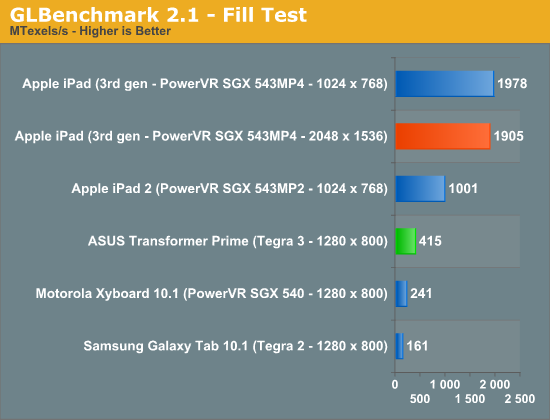
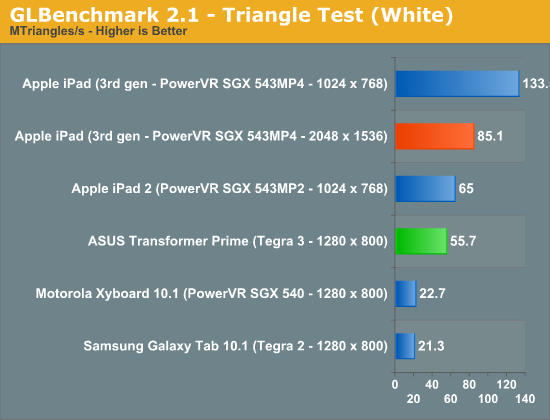
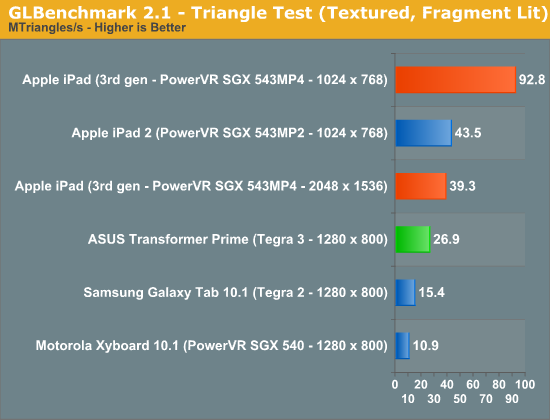
Indeed we see a roughly 2x increase in triangle and fill rates. Below we have the output from GLBenchmark's low level tests. Pay particular attention to how, at 1024 x 768, performance doubles compared to the iPad 2 but at 2048 x 1536 performance can drop to well below what the iPad 2 was able to deliver at 10 x 7. It's because of this drop in performance at the iPad's native resolution that we won't see many (if any at all), visually taxing games run at anywhere near 2048 x 1536.
| GLBenchmark 2.1.3 Low Level Comparison | ||||||
| iPad 2 (10x7) | iPad 3 (10x7) | iPad 3 (20x15) | ASUS TF Prime | |||
| Trigonometric test—vertex weighted |
35 fps
|
60 fps
|
57 fps
|
47 fps
|
||
| Trigonometric test—fragment weighted |
7 fps
|
14 fps
|
4 fps
|
20 fps
|
||
| Trigonometric test—balanced |
5 fps
|
10 fps
|
2 fps
|
9 fps
|
||
| Exponential test—vertex weighted |
59 fps
|
60 fps
|
60 fps
|
41 fps
|
||
| Exponential test—fragment weighted |
25 fps
|
49 fps
|
13 fps
|
18 fps
|
||
| Exponential test—balanced |
19 fps
|
37 fps
|
8 fps
|
7 fps
|
||
| Common test—vertex weighted |
49 fps
|
60 fps
|
60 fps
|
35 fps
|
||
| Common test—fragment weighted |
8 fps
|
16 fps
|
4 fps
|
28 fps
|
||
| Common test—balanced |
6 fps
|
13 fps
|
2 fps
|
12 fps
|
||
| Geometric test—vertex weighted |
57 fps
|
60 fps
|
60 fps
|
27 fps
|
||
| Geometric test—fragment weighted |
12 fps
|
24 fps
|
6 fps
|
20 fps
|
||
| Geometric test—balanced |
9 fps
|
18 fps
|
4 fps
|
9 fps
|
||
| For loop test—vertex weighted |
59 fps
|
60 fps
|
60 fps
|
28 fps
|
||
| For loop test—fragment weighted |
30 fps
|
57 fps
|
16 fps
|
42 fps
|
||
| For loop test—balanced |
22 fps
|
43 fps
|
11 fps
|
15 fps
|
||
| Branching test—vertex weighted |
58 fps
|
60 fps
|
60 fps
|
45 fps
|
||
| Branching test—fragment weighted |
58 fps
|
60 fps
|
30 fps
|
46 fps
|
||
| Branching test—balanced |
22 fps
|
43 fps
|
16 fps
|
16 fps
|
||
| Array test—uniform array access |
59 fps
|
60 fps
|
60 fps
|
60 fps
|
||
| Fill test—Texture Fetch |
1001483136 texels/s
|
1977874688
texels/s |
1904501632
texels/s |
415164192
texels/s |
||
| Triangle test—white |
65039568
triangles/s |
133523176
triangles/s |
85110008
triangles/s |
55729532
triangles/s |
||
| Triangle test—textured |
56129984
triangles/s |
116735856
triangles/s |
71362616
triangles/s |
54023840
triangles/s |
||
| Triangle test—textured, vertex lit |
45314484
triangles/s |
93638456
triangles/s |
46841924
triangles/s |
28916834
triangles/s |
||
| Triangle test—textured, fragment lit |
43527292
triangles/s |
92831152
triangles/s |
39277916
triangles/s |
26935792
triangles/s |
||
GLBenchmark also includes two tests designed to be representative of a workload you could see in an actual 3D game. The older Pro test uses OpenGL ES 1.0 while Egypt is an ES 2.0 test. These tests can either run at the device's native resolution with vsync enabled, or rendered offscreen at 1280 x 720 with vsync disabled. The latter offers us a way to compare GPUs without device screen resolution creating unfair advantages.
Unfortunately there was a bug in the iOS version of GLBenchmark 2.1.2 that resulted in all on-screen benchmarks running at 1024 x 768 rather than the new iPad's native 2048 x 1536 resolution. This is why all of the native GLBenchmark scores from the new iPad are capped at 60 fps. It's not because the new GPU is fast enough to render at speeds above 60 fps at 2048 x 1536, it's because the benchmark is actually showing performance at 1024 x 768. Luckily, GLBenchmark 2.1.3 fixes this problem and delivers results at the new iPad's native screen resolution:

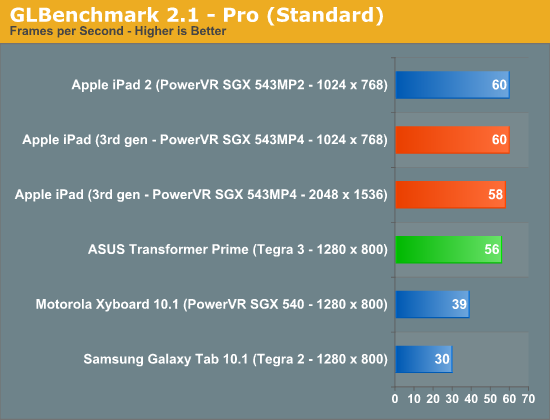
Surprisingly enough, the A5X is actually fast enough to complete these tests at over 50 fps. Perhaps this is more of an indication of how light the Egypt workload has become, as the current crop of Retina Display enhanced 3D titles for the iPad all render offscreen to a non-native resolution due to performance constraints. The bigger takeaway is that with the 543MP4 and a quad-channel LP-DDR2 interface, it is possible to run a 3D game at 2048 x 1536 and deliver playable frame rates. It won't be the prettiest game around, but it's definitely possible.
The offscreen results give us the competitive analysis that we've been looking for. With a ~2x die size advantage, the fact that we're seeing a 2-3x gap in performance here vs. NVIDIA's Tegra 3 isn't surprising:
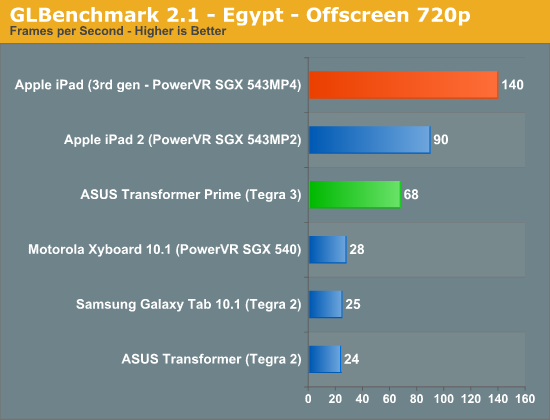
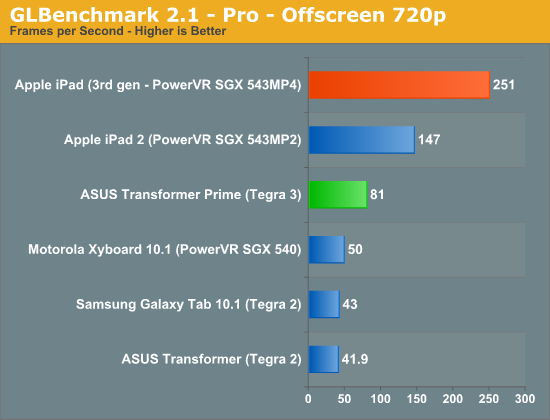
The bigger worry is what happens when the first 1920 x 1200 enabled Tegra 3 tablets start shipping. With (presumably) no additional GPU horsepower or memory bandwidth under the hood, we'll see this gap widen.










234 Comments
View All Comments
SixOfSeven - Thursday, March 29, 2012 - link
Any chance the glass is less likely to shatter on this one than on its predecessors?I didn't think so.
darkcrayon - Thursday, March 29, 2012 - link
The iPad 2's glass was much more resilient than that on the 1.. So who knows. I wonder if it's Gorilla Glass 2 and that's where a bit of weight savings came on the new iPad, considering the battery is so much larger yet the device is only slightly heavier.pdjblum - Thursday, March 29, 2012 - link
So you convinced yourself there is a use for it as it is "the world's greatest netbook" to your mind. Yet you can get a much more powerful intel notebook for about the same price or less. It is nothing more than an expensive indulgence. It is anything but enthusiast gear. Oh, I forgot, this has become another gadget site that loves crapple.kepler - Thursday, March 29, 2012 - link
That isn't true at all. Wait until you read the review for the Transformer Prime Infinity, it will be just as detailed, and I'm sure they'll like it just as much (or more) than the iPad3.I dislike Apple for a number of reasons, but I don't feel AnandTech has shown any bias.
darkcrayon - Thursday, March 29, 2012 - link
Not that you're anywhere close to reality, but I wonder why all these "gadget sites" seem to "love" Apple? Maybe because they make good products that people enjoy using? Naah, must be some hidden conspiracy. You're the one that knows the real deal, right?Everyone knows you can get a more powerful intel netbook for the same price. You can also get a more powerful intel netbook than smartphones which also cost more than the iPad. Oddly enough, you will not find an intel netbook on the market now with a screen anywhere near as nice as the iPad. Cool times we live in, eh?
doobydoo - Sunday, April 1, 2012 - link
Can you tell me which 'more powerful' intel notebook you can get which is capable of gaming at 2048 x 1536 at 60 fps and has a battery life over 9 hours, as well as being ultra-portable and light, instantly turns on, has a camera and built in 4G, at less than or the same price as the iPad?Good luck.
Lil Cheney - Thursday, March 29, 2012 - link
Wondering why as you review the A5x, you never use a Snapdragon chip for comparison, in addition to the Tegra 2 and 3?PeteH - Thursday, March 29, 2012 - link
Might be the lack of a shipping product to benchmark it against. The only performance numbers I've seen for an S4 came from Qualcomm's reference design.dagamer34 - Friday, March 30, 2012 - link
I'm actually not aware of any major tablets that use a Snapdragon chip. Most went with Tegra 2 early on, then moved to the OMAP 4 platform later in the year last year.siddharth7 - Thursday, March 29, 2012 - link
Well, the review is just amazing! Though its late than other sites, it was worth the wait. You went into so much of detail that I was just blown away. Photos are also great. Waiting for more reviews like this.Keep up the good work.
BTW, am I the only Indian commenting here expect the staff.
Thanks Anandtech.